Baked Spaghetti Pie
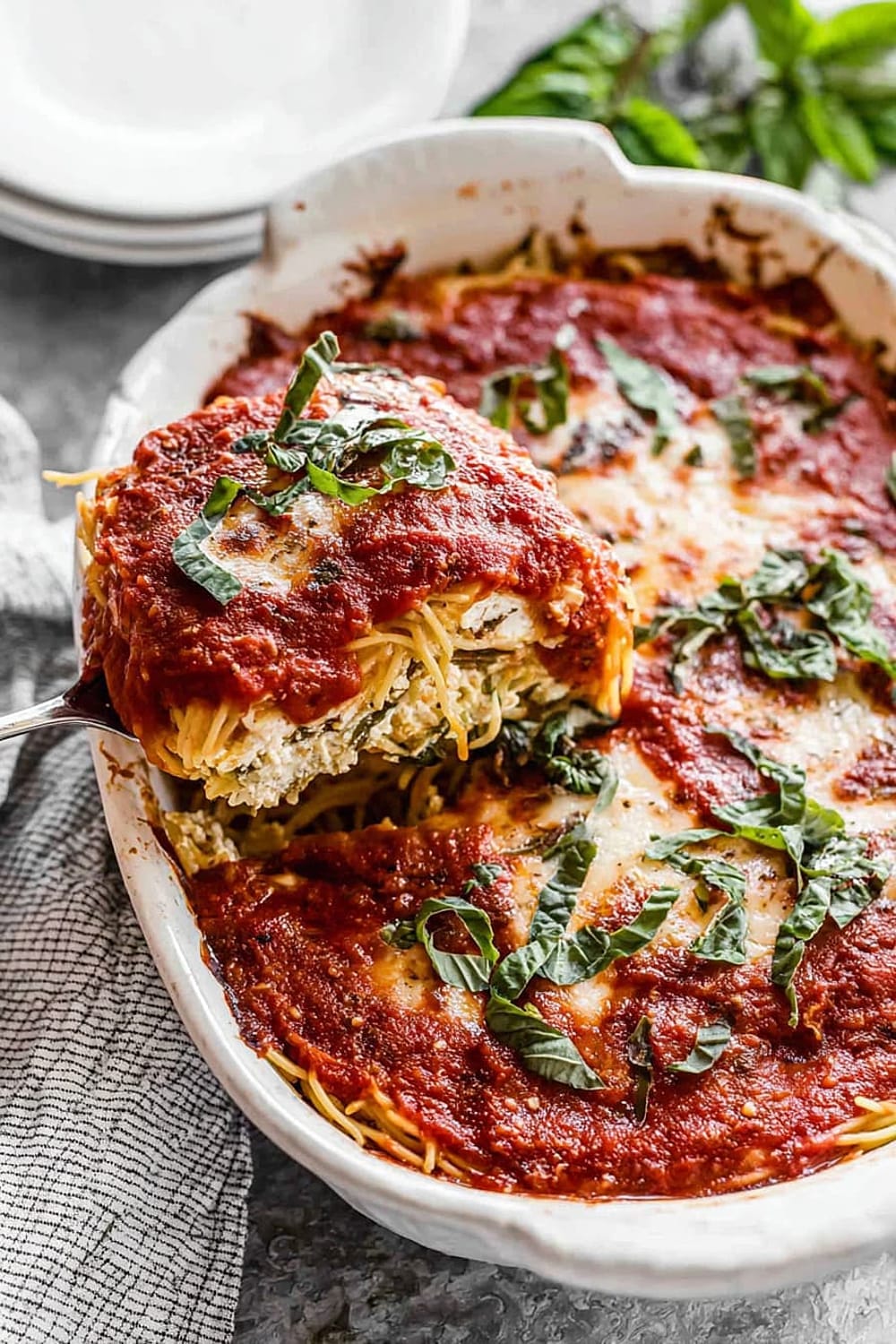
This is the kind of recipe that makes people think you went to culinary school, when really you just threw some pasta in a pie pan and called it fancy.

One bite of this crispy-edged, cheese-loaded masterpiece and you’ll wonder why regular spaghetti even exists.

The genius lies in transforming ordinary pasta into something that looks like you actually planned dinner instead of staring into the fridge hoping for inspiration.

Picture this: tender spaghetti noodles mixed with buttery parmesan and fresh basil, forming a golden crust that gives way to creamy cottage cheese and rich marinara sauce.
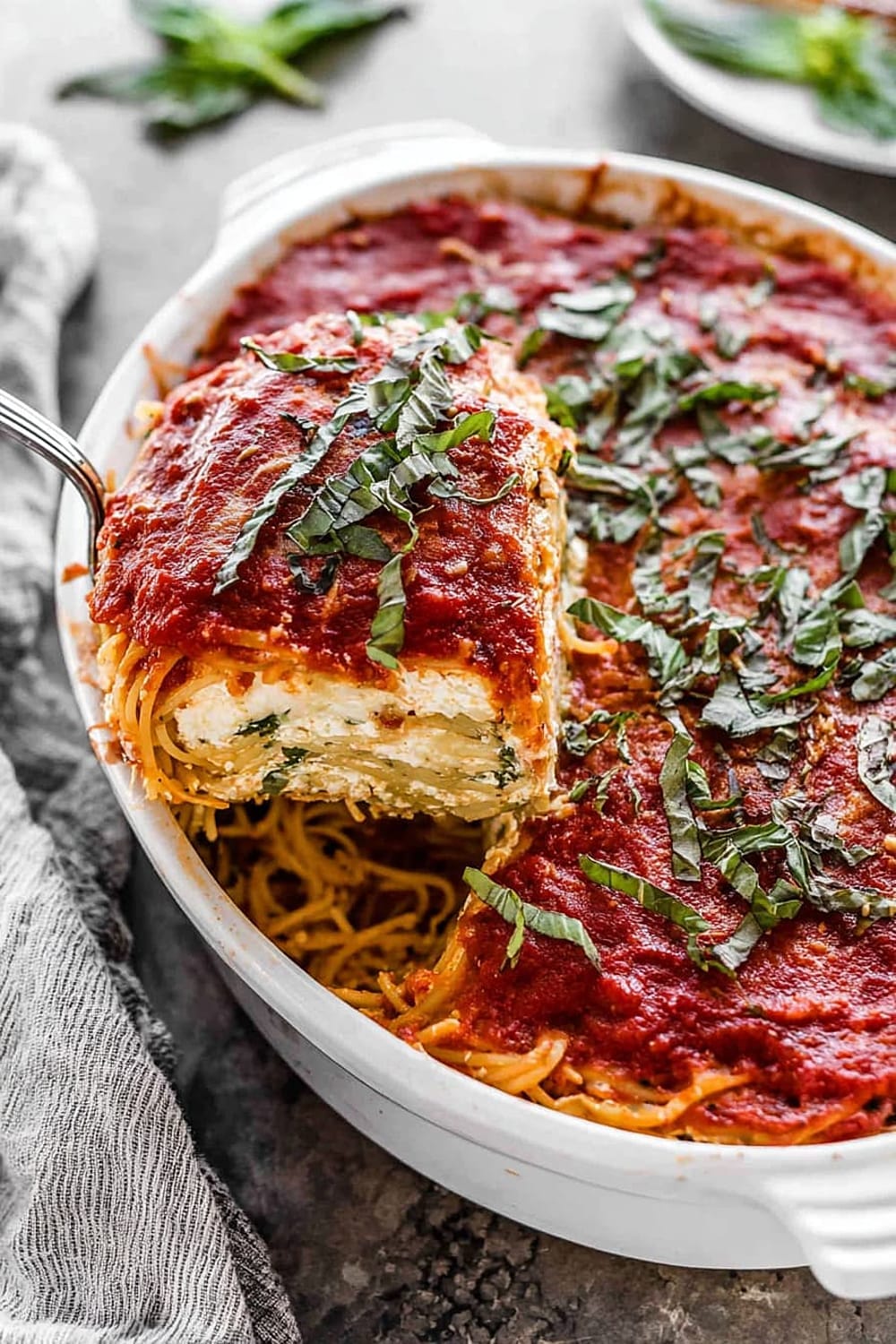
It’s basically comfort food cosplaying as sophisticated cuisine, and honestly, we’re here for it.

Plus, you can slice it into perfect wedges like an actual pie, which means you get to use your fancy pie server and pretend you have your life together.
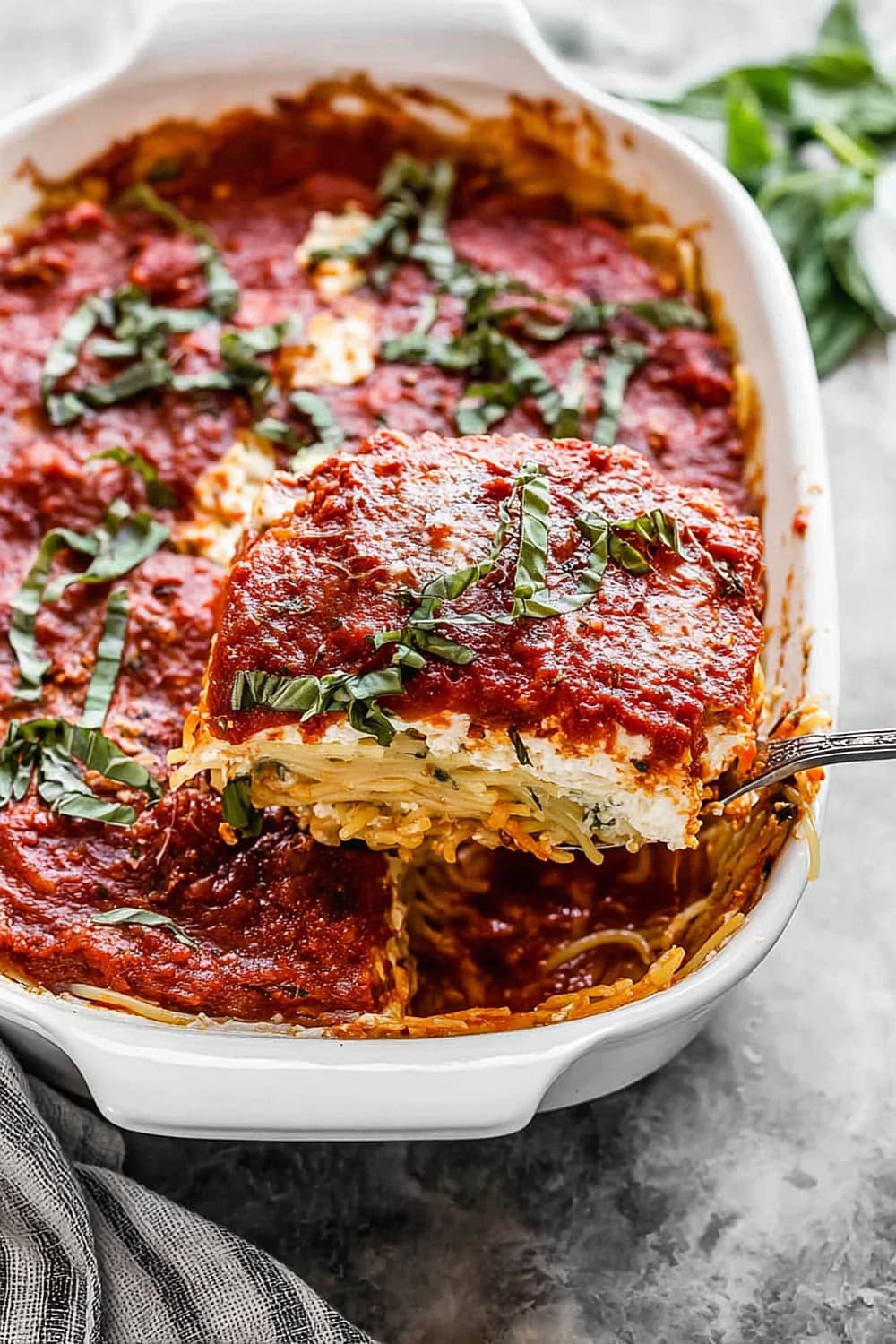
Ingredients
For the Pasta Base
- 8 ounces spaghetti noodles
- 1 cup freshly grated parmesan cheese
- 1 /4 cup fresh basil leaves, chopped
- 3 tablespoons butter, softened
- 1 large egg
- Salt and freshly ground black pepper, to taste
For the Filling
- 1 cup cottage cheese or ricotta
- 1 1/2 cups marinara pasta sauce, homemade or store-bought
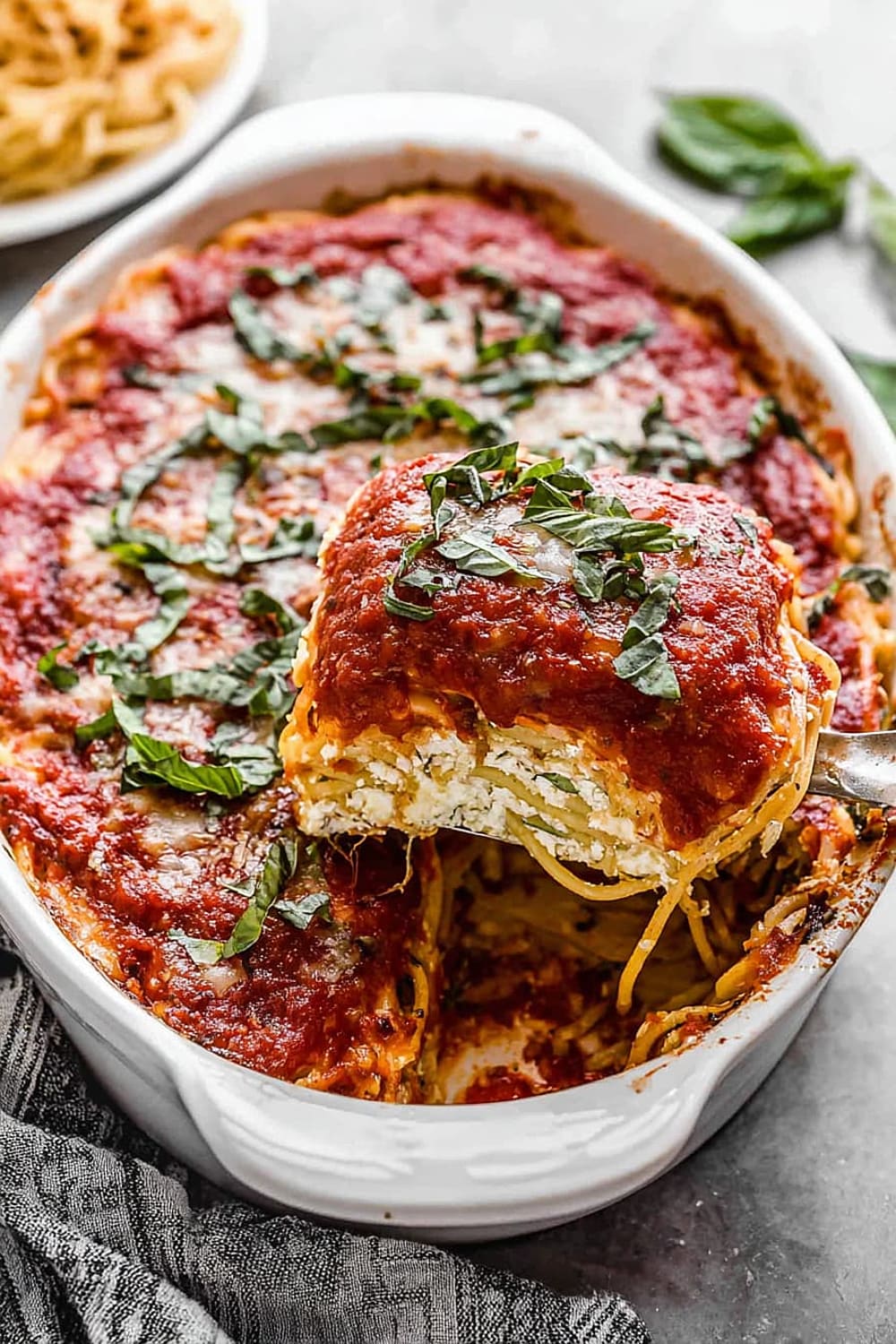
Instructions
Preparation
- 1 Preheat oven to 350°F (175°C) and lightly grease a deep dish pie plate with cooking spray. Using a quality non-stick cooking spray ensures easy release and prevents the pasta from sticking to your pie plate.
- 2 Cook 8 ounces spaghetti noodles according to package directions until al dente. This usually takes 8-10 minutes in boiling salted water. Drain immediately and add the hot noodles to a large mixing bowl – the residual heat is crucial for the next step.
Creating the Pasta Base
- 3 In a small bowl, beat 1 large egg until well combined. Add the 3 tablespoons softened butter and the warm pasta to the large bowl. Toss everything together until the butter is completely melted and coating the noodles. The heat from the pasta will gently cook the egg, creating a silky binding agent.
- 4 Add 1 cup freshly grated parmesan cheese, 1/4 cup chopped fresh basil, and season with salt and freshly ground black pepper to taste. Toss everything gently but thoroughly to combine. The mixture should be well-coated and aromatic from the fresh basil.
- 5 Empty the pasta mixture into your prepared pie pan and pat it firmly into place, creating an even layer that reaches up the sides slightly. Use clean hands or the back of a large spoon to press it down – this creates the “crust” that will become beautifully golden.
Assembly and Baking
- 6 Spread 1 cup cottage cheese evenly over the top of the pasta base, creating a smooth middle layer. If using ricotta instead, the texture will be slightly richer and creamier.
- 7 Spoon 1 1/2 cups marinara sauce over the cottage cheese layer and smooth it into an even layer using the back of a spoon. Make sure the sauce reaches the edges to prevent the pasta from drying out during baking.
- 8 Bake for 20 minutes until the edges are golden brown and the center is set. The top should be bubbling slightly around the edges, and the pasta crust should have a beautiful golden color.
- 9 Allow to cool for 5-10 minutes before slicing into wedges and serving. This cooling time lets the layers set properly, making it much easier to cut clean slices that hold their shape.
Storage
- 10 Store leftover spaghetti pie in the refrigerator for 3-4 days. Reheat individual portions in the microwave for 1-2 minutes, or reheat larger portions in a 300°F (150°C) oven for 10-15 minutes until warmed through.

Recommended Equipment and Kitchen Tools
Essential Tools (for best results):
- Deep dish pie plate – A 9-inch ceramic or glass pie plate works perfectly and conducts heat evenly for that golden crust. Cast iron pie pans are excellent for extra crispy edges.
- Large mixing bowls – You’ll need at least one large bowl for combining the pasta mixture, plus a smaller bowl for beating the egg.
- Microplane grater – Fresh parmesan makes all the difference, and a quality grater ensures fluffy, evenly distributed cheese that melts beautifully.
- Silicone spatula – Perfect for gently tossing the pasta mixture without breaking the noodles, and essential for spreading the cottage cheese layer smoothly.
Helpful Upgrades:
- Kitchen scale – For precise measurements, especially if you’re doubling the recipe or want consistent results every time.
- Instant-read thermometer – While not essential, checking that the center reaches 165°F (74°C) ensures food safety and perfect doneness.
Nice-to-Have Options:
- Mandoline slicer – If you want to add thin vegetable layers or create garnish elements for presentation.
- Parchment paper – Line your pie plate for even easier removal, though cooking spray works perfectly fine for this recipe.
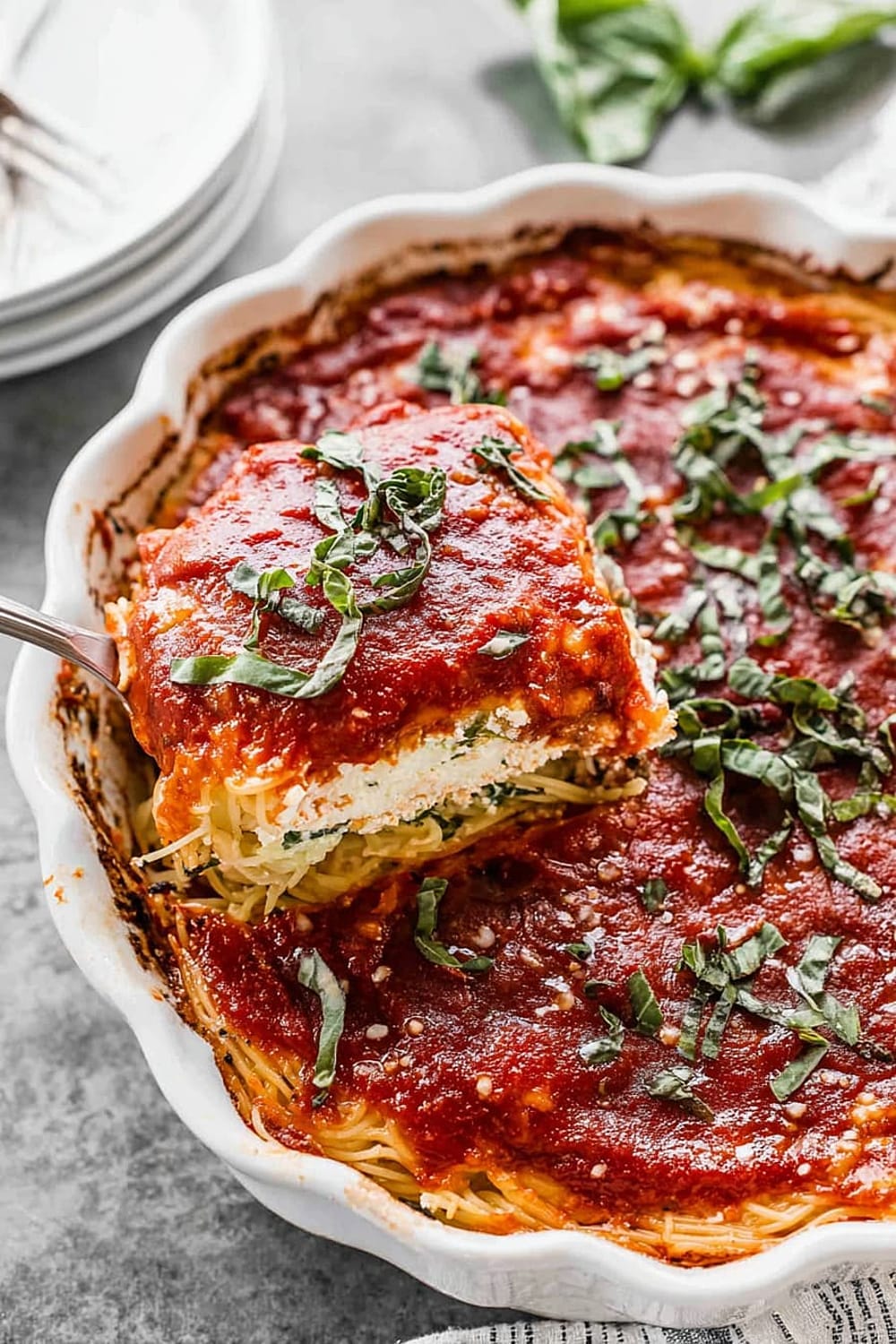
Recipe Variations and Dietary Modifications
Gluten-Free Adaptation:
- Replace regular spaghetti with 8 ounces gluten-free pasta (corn, rice, or chickpea varieties work well)
- Cook gluten-free pasta 1-2 minutes less than package directions as it can become mushy quickly
- Add 1 tablespoon extra butter to help bind the mixture, as gluten-free pasta doesn’t hold together as naturally
- Expect a slightly different texture – less chewy but still delicious
Dairy-Free Modifications:
- Substitute vegan butter for regular butter in equal amounts
- Replace parmesan with nutritional yeast (use 1/2 cup for similar flavor intensity)
- Use dairy-free ricotta or cashew cream instead of cottage cheese
- Choose a dairy-free marinara sauce to ensure the entire dish is dairy-free
Protein-Packed Variations:
- Add 1 cup cooked ground turkey or beef mixed into the marinara layer
- Incorporate 1/2 cup cooked Italian sausage for extra flavor and substance
- Mix 1/4 cup pine nuts into the pasta base for added protein and crunch
- Use high-protein pasta made from lentils or chickpeas
Vegetable-Forward Options:
- Layer 1 cup sautéed spinach between the cottage cheese and marinara
- Add 1/2 cup roasted bell peppers to the pasta mixture
- Include 1/4 cup sun-dried tomatoes for intense flavor bursts
- Top with sliced fresh tomatoes before baking for extra freshness
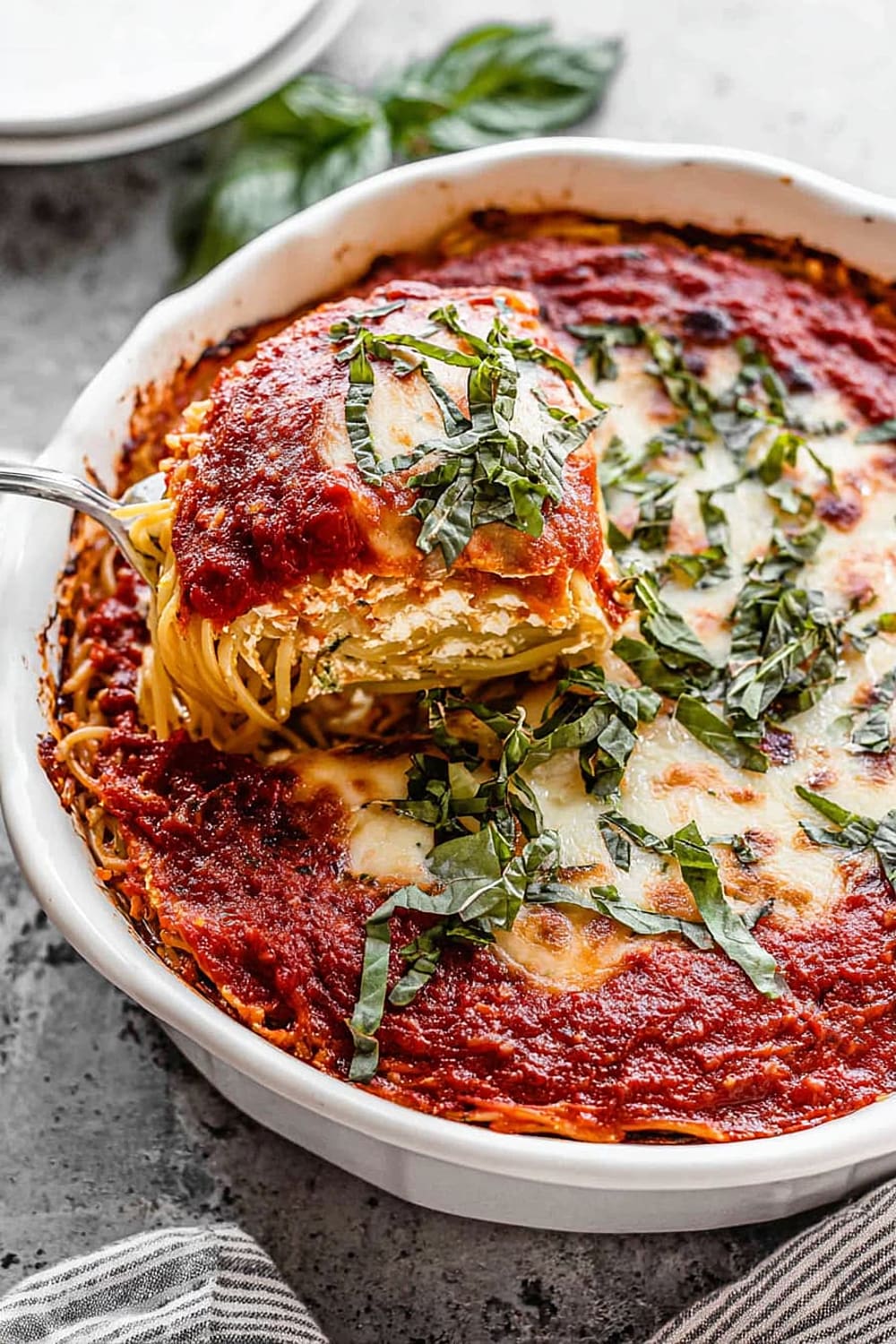
Nutritional Information and Health Benefits
Key Nutritional Highlights:
This baked spaghetti pie provides approximately 320 calories per serving when cut into 6 generous portions. The combination of pasta, cheese, and egg delivers a balanced mix of 45 grams carbohydrates, 18 grams protein, and 8 grams fat per serving. The cottage cheese contributes significant protein while keeping the fat content moderate, making this a satisfying meal that provides sustained energy.
Health Benefits of Main Ingredients:
The fresh basil provides antioxidants and anti-inflammatory compounds, plus vitamin K for bone health. Parmesan cheese delivers high-quality protein and calcium, essential for bone strength and muscle function. Cottage cheese is a nutritional powerhouse, offering casein protein that digests slowly and helps maintain stable blood sugar levels. The eggs provide complete protein with all essential amino acids, plus choline for brain health. Marinara sauce contributes lycopene from tomatoes, a powerful antioxidant that supports heart health and may have cancer-protective properties.
Dietary Considerations:
This recipe contains gluten from wheat pasta, dairy from multiple cheese sources, and eggs. It’s naturally vegetarian and provides a good balance of macronutrients. The high protein content from cheese and eggs makes it more filling than regular pasta dishes, potentially helping with portion control. The dish provides approximately 3 grams fiber per serving, which can be increased by using whole wheat pasta or adding vegetables.

Smart Swaps and Ingredient Substitutions
Common Substitutions:
- Cottage cheese → Ricotta cheese (1:1 ratio, creates richer texture)
- Fresh basil → Dried basil (use 1 tablespoon dried for 1/4 cup fresh)
- Parmesan cheese → Romano or Asiago (equal amounts, slightly sharper flavor)
- Butter → Olive oil (use 2 tablespoons instead of 3 tablespoons butter)
Budget-Friendly Swaps:
- Fresh parmesan → Pre-grated parmesan (texture won’t be as fluffy but flavor remains good)
- Fresh basil → Dried Italian seasoning (use 1 tablespoon for herb blend flavor)
- Homemade marinara → Quality jarred sauce (look for low-sodium options)
Pantry Emergency Substitutions:
- Cottage cheese → Cream cheese mixed with milk (soften 6 oz cream cheese with 2 tablespoons milk)
- Fresh egg → Egg substitute (use 1/4 cup liquid egg substitute)
- Marinara sauce → Pizza sauce (similar consistency and flavor profile)
Pro Tips for Substitutions:
- When using ricotta instead of cottage cheese, drain excess liquid by placing in a fine-mesh strainer for 15 minutes
- If substituting dried herbs for fresh, add them earlier in the cooking process to allow flavors to develop
- Store opened jarred marinara in refrigerator for up to 1 week after opening
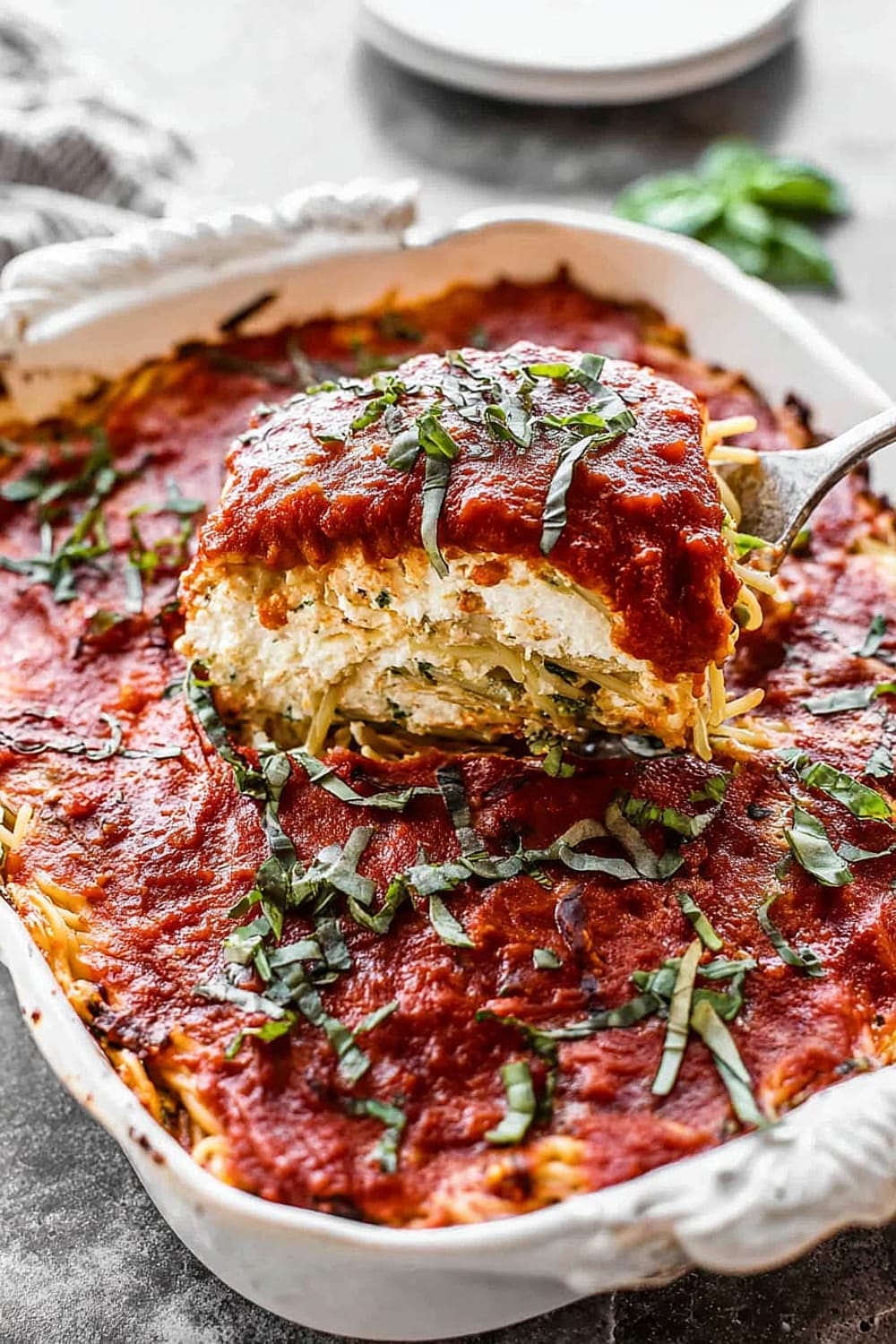
Make It Diabetes-Friendly
Carb Reduction Strategies:
- Replace regular spaghetti with shirataki noodles or zucchini noodles to reduce carbs by approximately 35 grams per serving
- Use whole wheat pasta to increase fiber content, which helps slow glucose absorption
- Reduce pasta portion to 6 ounces and add 1 cup sautéed vegetables to maintain volume while cutting carbs by 15 grams
Protein Enhancement:
- Increase cottage cheese to 1 1/2 cups to boost protein content and improve blood sugar stability
- Add 1/2 cup cooked lean ground turkey to the marinara layer for additional protein without significant carb increase
- Include 2 tablespoons ground flaxseed in the pasta mixture for fiber and healthy fats
Portion & Timing Tips:
- Cut into 8 smaller wedges instead of 6 for better portion control (approximately 28 grams carbs per piece)
- Serve with a large mixed green salad to increase fiber and nutrients while maintaining satisfaction
- Pair with lean protein like grilled chicken breast to further stabilize blood sugar response
- Consider eating this as a lunch option when you’re more active, allowing better glucose utilization
Total Carb Reduction: These modifications can reduce carbohydrates from 45 grams to approximately 25-30 grams per serving while maintaining the satisfying, comfort-food experience.

Perfect Pairing Suggestions
Beverage Pairings:
A medium-bodied Chianti or Sangiovese complements the tomato-based marinara beautifully, while the acidity cuts through the rich cheese layers. For white wine lovers, a crisp Pinot Grigio provides a refreshing contrast to the hearty pasta. Beer enthusiasts should try a wheat beer or light lager that won’t compete with the delicate basil flavors. Non-alcoholic options include sparkling water with lemon, iced tea with fresh herbs, or Italian sodas for a festive touch.
Side Dish Recommendations:
A crisp Caesar salad with crunchy romaine and tangy dressing provides the perfect textural contrast to the creamy pie. Roasted vegetables like zucchini, bell peppers, or asparagus add color and nutrients while complementing the Italian flavors. Garlic bread might seem redundant with pasta, but a light bruschetta with fresh tomatoes and basil echoes the pie’s flavors beautifully. Steamed broccoli with lemon offers a fresh, healthy balance to the rich main dish.
Complete Meal Ideas:
Start with antipasto skewers featuring olives, cherry tomatoes, and mozzarella balls for an elegant appetizer that builds anticipation. Follow the spaghetti pie with fresh fruit sorbet or tiramisu for dessert to maintain the Italian theme. For casual entertaining, serve family-style with multiple salads and let guests customize their plates. Holiday presentations can include the pie as part of a larger Italian feast with multiple pasta options.
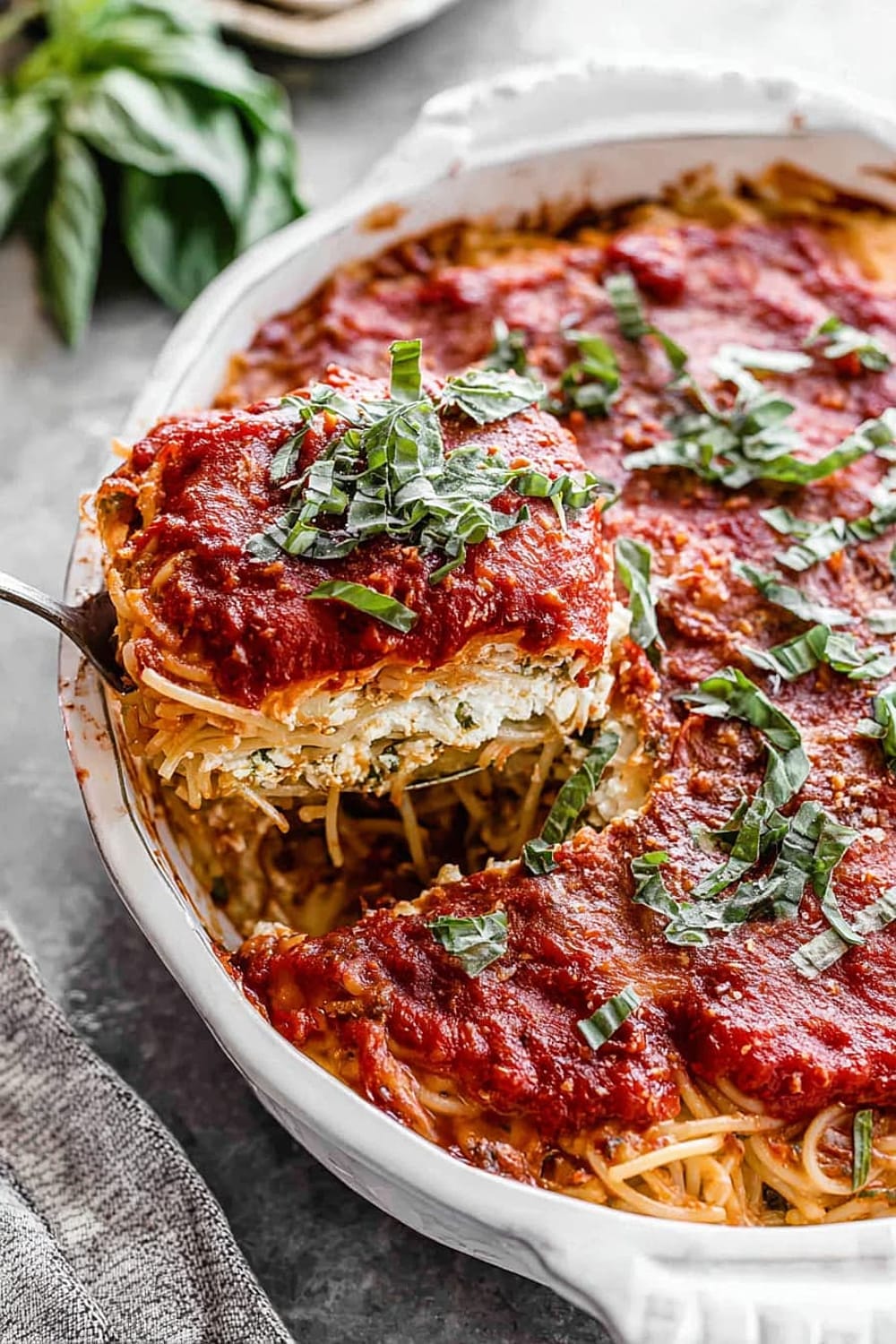
Pro Tips and Troubleshooting
Professional Techniques:
Salt your pasta water generously – it should taste like seawater. This is your only chance to season the pasta itself, and under-seasoned pasta will make the entire dish bland. Save some pasta cooking water before draining; the starchy liquid can help bind the mixture if it seems too dry. Press the pasta mixture firmly into the pie plate – loose packing leads to a pie that falls apart when sliced.
Common Mistake Prevention:
Don’t skip the cooling time – cutting too early results in a messy, sauce-everywhere situation that looks nothing like the elegant slices you’re aiming for. Avoid overcooking the pasta initially, as it continues cooking in the oven and mushy pasta creates a soggy pie. Room temperature ingredients mix more easily – take your butter and egg out 30 minutes before cooking.
Storage and Make-Ahead Strategies:
This pie actually improves overnight in the refrigerator as flavors meld together. Assemble completely up to 24 hours ahead, cover tightly with plastic wrap, and bake when ready to serve. Freeze portions individually wrapped for up to 3 months – perfect for quick weeknight dinners. Reheat from frozen in a 300°F (150°C) oven for 25-30 minutes, covering with foil to prevent over-browning.
Scaling and Presentation:
Double the recipe easily using a 9×13 inch baking dish instead of a pie plate – perfect for feeding crowds or meal prep. Individual portions can be made in ramekins for elegant presentation – reduce baking time to 15 minutes. Garnish with fresh basil leaves and a light dusting of parmesan just before serving for restaurant-quality presentation.

This baked spaghetti pie proves that sometimes the best recipes come from thinking outside the traditional pasta bowl. With its crispy edges, creamy center, and ability to slice into perfect wedges, it transforms a simple weeknight dinner into something special enough for company. Whether you’re meal prepping for the week or looking to impress dinner guests, this recipe delivers comfort food satisfaction with an elegant twist that makes everyone think you’re a much fancier cook than you actually are.